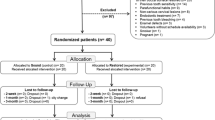Abstract
The aim of this clinical study was to evaluate whether or not an association exists between the presence of enamel craze lines and the prevalence of tooth sensitivity (TS) after in-office bleaching. Subjects that met the inclusion criteria (N = 23) were screened to detect the existence of enamel craze lines. In total, 460 teeth were subjected to bleaching where 49 % of them presented enamel craze lines. After bleaching (15 % hydrogen peroxide), the subjects were asked to rate the level of TS by answering a self-administered questionnaire. The majority of subjects (91 %) experienced TS at the first day of bleaching. The TS prevalence decreased gradually to 22 % at second day, to 17 % at third day, and to 9 % at fourth day. After the fourth day, no subject reported TS. While 15 % of teeth with craze lines presented TS, 11 % of teeth with no craze lines also showed TS. A positive but weak correlation (r = 0.214) was found between the existence of enamel craze lines and TS. In this clinical study, higher incidence of TS was found with the use of 15 % hydrogen peroxide bleaching agent compared to the previous studies. Patients who would undergo in-office bleaching should be informed that tooth sensitivity is a very often side effect but it may disappear within 1 week.


Similar content being viewed by others
References
Setien VJ, Roshan S, Nelson PW. Clinical management of discolored teeth. Gen Dent. 2008;56:294–300.
Chhabra N, Singbal KP. Viable approach to manage superficial enamel discoloration. Contemp Clin Dent. 2010;1:284–7.
Kwon SR. Whitening the single discolored tooth. Dent Clin North Am. 2011;55:229–39.
Nathanson D, Parra C. Bleaching vital teeth: a review and clinical study. Compend Contin Educ Dent. 1987;8:490–7.
Rosenblum MA, Nathoo SA. Clinical study to evaluate the safety and efficacy of the BriteSmile 2000 In-Office tooth whitening system. Doctorate Thesis. NJ Dental School, University of Medicine and Dentistry of New Jersey, Newark, NJ. 2000.
Tavares M, Stultz J, Newman M, Smith V, Kent R, Carpino E, Goodson JM. Light augments tooth whitening with peroxide. J Am Dent Assoc. 2003;134:167–75.
Tredwin CJ, Naik SN, Lewis J, Scully C. Hydrogen peroxide tooth-whitening (bleaching) products: review of adverse effects and safety issues. Br Dent J. 2006;200:371–6.
Cohen SC, Chase C. Human pulpal response to bleaching procedures on vital teeth. J Endod. 1979;5:134–8.
Howard WR. Patient-applied tooth whiteners, are they safe, effective with supervision? J Am Dent Assoc. 1992;123:57–60.
Haywood VB, Leonard RH, Nelson CF, Brunson WD. Effectiveness, side effects and long-term status of nightguard vital bleaching. J Am Dent Assoc. 1994;125:1219–26.
Schulte JR, Morrisette DB. The effects of bleaching application time on the dental pulp. J Am Dent Assoc. 1994;125:1330–5.
Jorgensen M, Carroll W. Incidence of tooth sensitivity after home whitening treatment. J Am Dent Assoc. 2002;133:1076–82.
Bowles WH, Ugwuneri Z. Pulp chamber penetration by hydrogen peroxide following vital bleaching procedure. J Endod. 1987;13:375–7.
Cooper J, Bokmeyer T, Bowles W. Penetration of the pulp chamber by carbamide peroxide bleaching agents. J Endod. 1992;18:315–7.
Gökay O, Tunçbilek M, Ertan R. Penetration of the pulp chamber by carbamide peroxide bleaching agents on teeth restored with a composite resin. J Oral Rehabil. 2000;27:428–31.
Dahl JE. Tooth Bleaching—a critical review of the biological aspects. Int Am Assoc Dent Res. 2003;14(4):292–304.
Lynch C, Mc Connell R. The cracked tooth syndrome. J Can Dent Assoc. 2002;68:470–5.
Clark D, Sheets C, Paquette J. Definitive diagnosis of early enamel and dentin cracks based on microscopic evaluation. J Esthet Restor Dent. 2003;15:391–401.
Davich M. Clinical detection and decision-making considerations for cracked teeth. Endod Therapy. 2004;4:4–7.
Hewlett E. Etiology and management of whitening-induced tooth hypersensitivity. J Calif Dent Assoc. 2007;35:499–506.
Zamboni SC, Castanho GM, Torres CR, Nogueira L Jr, Borges AB, Bottino MA. Influence of the coloring agent concentration on bleaching gel and pulp chamber temperatures during dental bleaching. Gen Dent. 2010;58:e36–41.
Kabbach W, Zezell DM, Pereira TM, Albero FG, Clavijo VR, de Andrade MF. A thermal investigation of dental bleaching in vitro. Photomed Laser Surg. 2008;26:489–93.
Conflict of interest
The authors declare that they have no conflict of interest.
Author information
Authors and Affiliations
Corresponding author
Rights and permissions
About this article
Cite this article
Özcan, M., Abdin, S. & Sipahi, C. Bleaching induced tooth sensitivity: do the existing enamel craze lines increase sensitivity? A clinical study. Odontology 102, 197–202 (2014). https://doi.org/10.1007/s10266-013-0104-7
Received:
Accepted:
Published:
Issue Date:
DOI: https://doi.org/10.1007/s10266-013-0104-7




